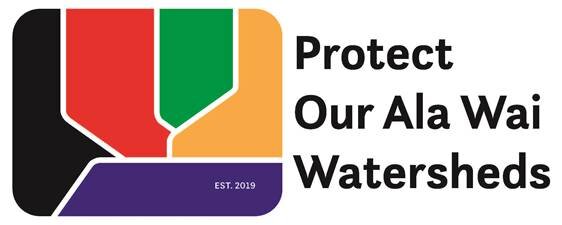The Ala Wai Watersheds include from The Pali ridges above Manoa and Palolo Valleys, to Makiki and the Ala Wai areas and Waikiki. In Manoa Valley is The Manoa Stream and in Palolo Valley are The Pukele Stream and The Waiomao Stream. These Island Streams join together near the Ewa end of Waialae Avenue to become The Manoa/Palolo Drainage Canal which flows into The Ala Wai Canal.
In ancient times and the recent past and with the plentiful waters flowing from the Ala Wai Watersheds, these valleys were principally cultivated with Kalo using the Lo’i agricultural system from The Pali to Waikiki in a most sophisticated way, providing ample nourishment for the Hawaiian population. In ancient Hawai`i, taro played a much larger role beyond dietary staple. At the economic, political and spiritual center of Hawaiian agricultural society, the taro plant and its history grew to mythological proportions.
With the inevitable development of these areas in modern times came the diminishment of this effective Hawaiian agricultural system as the Hawaiian’s self-dependency was destroyed by the otherwise intentioned actions by foreign invaders.
Overview of the History of Waikiki and the Ala Wai Canal
The creation of the Ala Wai artificial waterway during the 1920s enabled the destruction of a native culture in Waikiki and the building of a tourist mecca on its ruins. Within just eight years after the 1893 illegal overthrow of the Hawaiian Kingdom, Waikiki was becoming a popular enclave of the newcomers and well-to-do vacationers when the luxurious Moana Hotel was opened in 1901. Oral tradition and archeological records indicate that Waikiki was well established as a settlement and farming center by the fifteenth century.
“Long before it became a tourist mecca, Waikiki (Place of Spouting Waters) was a watery expanse fed by mountain streams, underground springs, and ocean waves. Its waters irrigated taro plantations, which in turn fed man-made ponds rich in fish and seaweed. Waikiki nourished the spirits of Native Hawaiians as well as their bodies. The area was considered sacred; several heiau (temples) were built and many came for spiritual healing. Early Asian immigrants to Hawai‘i continued to raise fish in Waikiki, as well as duck, and cultivated acres of rice paddies. Only in the last century would Waikîkî’s waters be drained (during the 1920s to build the Ala Wai Canal and use dredged material from the canal to fill in the nearby wetlands and allow Waikiki to grow as a tourist mecca), purportedly to combat disease carried by mosquitoes, but actually designed to drain the fish ponds and lo’i and so make the land uninhabitable to Native Hawaiians and other settlers. The Ala Wai Canal transformed Waikiki from a self-sustaining Native Hawaiian community to an urban resort. It initiated a relentless reclamation of land for defense and building by military officials, government leaders, and businessmen, thereby ravaging Waikiki’s natural environment and displacing its indigenous people to make way for military installations and hotels.” (Waikiki: A History of Forgetting & Remembering by Gaye Chan and Andrea Feeser, 2006.)
Today
Today, the Ala Wai Canal is one of the crowning jewels of Waikki and the proposed Ala Wai Flood Control Project as planned by the USACE will destroy over 600 trees and cause a wall to be built around the canal, forever ruining what is worth preserving.
““Ua mau ke ea o ka aina I ka pono”
”The life of the land is perpetuated in righteousness.”
- King Kamehameha III, July 31, 1843
”
WHAT HAS HAPPENED SO FAR
Over the past year and through vigorous advocacy and consistent public involvement, We have been able to get the attention of the government of The City of Honolulu as well as the US Army Corps of Engineers. When the Honolulu City Council proposed a resolution to have the Mayor move the project forward, we were able to present our objectives and reasons to the Neighborhood Boards in the Ala Wai Watersheds: Manoa, Palolo, Kaimuki, Diamond Head/Kapahulu/St. Louis Heights, McCully/Moiliili, Makiki, and Waikiki. From our informational efforts, each of these boards (with the exception of Waikiki) approved resolutions asking the Honolulu City Council to NOT pass their resolution that would allow the project to move forward. The Honolulu City Council passed their resolution with a vote of 5 - 4, ignoring the expression of the various Neighborhood Boards and the people who live in The Ala Wai Watersheds. The City Council did then engage a local group, OCEANIT, to evaluate alternatives and further engage the public which we appreciate. As the results of this engagement have yet to be published and time is running out to pause the project, we have been compelled to resort to litigation with The City of Honolulu to attempt to cause a pause in the process in order to be able to better consider alternates to the Flawed Plan. We are awaiting the court’s decision which is expected at the end of October.

